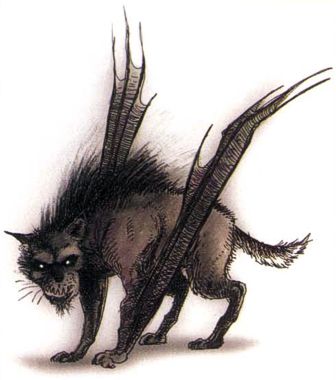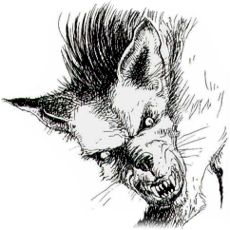

Dragon Mountain • Monstrous Compendium Annual, Volume One

| Normal | Winged | |
|---|---|---|
| Climate/Terrain: | Temperate/Forest or rough hills | Forest or rough hills |
| Frequency: | Uncommon | Rare |
| Organization: | Pack | Pack |
| Activity Cycle: | Day | Day |
| Diet: | Carnivore | Carnivore |
| Intelligence: | Semi- (2-4) | Low (5-7) |
| Treasure: | None | None |
| Alignment: | Chaotic evil | Chaotic evil |
| No. Appearing: | 2-20 | 2-12 |
| Armor Class: | 6 | 5 |
| Movement: | 15 | 12, Fl 6(E) |
| Hit Dice: | 3 | 4 |
| THAC0: | 17 | 17 |
| No. of Attacks: | 1 | 1 |
| Damage/Attack: | 1-6 | 1-8 |
| Special Attacks: | Nil | Surprise |
| Special Defenses: | Nil | Nil |
| Magic Resistance: | Nil | Nil |
| Size: | M (5-7’ long) | L (8-10’ long) |
| Morale: | Elite (13) | Elite (14) |
| XP Value: | 120 Leader: 175 | 270 Leader 650 |
 Created by a master sorcerer ages ago, these creatures most closely resemble dogs, but their wolfish snouts sport many more razor-sharp teeth than their canine cousins, and there is a bristly tuft of hair that grows between their shoulders. Coloration tends toward dark blacks, greys, and browns. Their eyes show evidence of the hatred and evil burning within their breasts, practically burning with the desire to kill and maim.
Created by a master sorcerer ages ago, these creatures most closely resemble dogs, but their wolfish snouts sport many more razor-sharp teeth than their canine cousins, and there is a bristly tuft of hair that grows between their shoulders. Coloration tends toward dark blacks, greys, and browns. Their eyes show evidence of the hatred and evil burning within their breasts, practically burning with the desire to kill and maim.
Combat: Gnashers live for the kill, and their tactics show it. When attacking, they circle their prey and then lunge in with snapping jaws, often trying for the throat. Their powerful jaws inflict 1d6 points of damage. Gnashers prefer to make jabbing attacks, circling and feigning, until they have sufficiently weakened their prey. Then they all lunge in at once, swarming and overbearing the prey from all directions until it goes down. Anyone taken down under a gnasher attack has little hope of survival. The prone victim’s AC is effectively reduced by 4 and the gnashers inflict an additional +2 points of damage per attack.
The only hope someone has of escaping a gnasher pack is to climb something the gnashers cannot ascend. However, if there is no other way down, gnashers have been known to stand guard until the prey dies of dehydration or attempts an escape.
Habitat/Society: Gnashers hunt in packs, following a leader that has earned its place by brute force (+1 Hit Die). As the leader ages, the younger toughs of the pack wait for a chance to displace it. Once this has occured, the remainder of the potential leaders fight for dominance, rarely to the death.
Even though gnashers are vicious, they avoid populated areas when possible, attacking those who wander into the wilderness. They are usually only encountered in the wilds, although at times smaller farming communities have trouble with packs of gnashers that kill livestock and lone villagers.
The pack communicates on a rudimentary level, using a combination of barks, growls, and body language. Although gnashers frequently squabble among themselves – fighting over food, pack dominance, and mates – they do not rise against each other if there are foes present. They only kill gnashers of other packs, since these are viewed as competitors in the struggle for survival in the wilds.
Ecology: Gnashers survive solely on meat. They attack nearly anything in the area, from rabbits to adventurers to low-flying birds. An area controlled by these creatures will be devoid of other animal life. Anyone entering the territory of a pack of gnashers will notice an eerie silence in an area cleaned out by them. It takes nearly a year for any animals to return to an area where a gnasher pack has made its home, even after the gnashers leave it for more fruitful pastures.
Gnashers mate in the spring, the female bearing 1d4+1 cubs that stay with the mother for the first year and are then forced out on their own. For many years these creatures were mistaken for dogs, until it was realized that they do not flee pain, and indeed seem to revel in it.
Their natural enemy is the elven dog, or cooshee. The two species hate each other and will attack upon first hint of the other. Even the typical canine surrender will not suffice for these two; no quarter is ever given.
These are slightly bigger cousins of normal gnashers, encountered only in areas with natural outcroppings of stone. They have batlike wings – thick membranes attached to their forelegs and running the length of their bodies – that enable them to leap into tine air from these outcroppings and glide for distances of 50 feet for every 10 feet of height from which they leaped. However, their wings tend to tire easily, and they cannot maintain glides of over 200 feet. They can also leap into the air from the ground and glide for 20 feet, but they suffer a -2 attack penalty when attempting to bring down a target from such a jump.
Winged gnashers are equally at home on the ground. Though they have wings, the membranes stretch enough that the gnashers can run quickly along the ground. Though they do not have the speed normal gnashers have, they can usually catch prey that does not have a running start.
Combat: Like normal gnashers, winged gnashers live for the kill and use tactics much like their land-based brethren, circling around their prey until it is surrounded, and then closing in with surprising speed. In addition to their circling tactics, winged gnashers also “fly” at prey, folding their wings and dropping down from heights of up to 20 feet to achieve surprise. This is equivalent to a charge attack, giving the winged gnasher a +2 attack bonus. However, they suffer a -1 AC penalty.
Habitat/Society: Winged gnashers (also known simply as “wings”) live in caves in the rough hills. They hardly ever sleep in the open, unless they are forced from their cave by something larger and fiercer than them. Their nests inside these caves are crude collections of straw and branches in which they sleep. There is usually very little treasure in a gnasher cave, since they have no use for it. They generally leave it on the carcasses of the creatures they kill.
Like their cousins, winged gnashers live in packs. Winged gnasher leaders have 1 extra Hit Die and are larger than the rest of the pack. Intrapack struggles are common, as the younger males wish to try their strength against that of their leader. Those who fail are driven from the pack to try and fend for themselves in the wild. Unfortunately for these exiles, most wilderness creatures take the opportunity to eliminate lone gnashers when they can.
Ecology: Winged gnashers generally feed off land-based creatures, since most flying creatures are far more mobile and aerially agile than they are. Only if they attack by surprise can winged gnashers bring down the majority of flying creatures, and only if that creature is flying less than 40 feet above the ground.
Gnashers have no regard for the balance of nature, and they tend to completely eliminate every sizeable creature in an area. These areas are notable for their lack of animal life, and gnashers do not stay long in a place they have cleaned out.
Winged gnashers find that most other aerial monsters are their natural enemies, especially griffons and hippogriffs. These creatures will put aside their differences in order to eliminate gnasher packs. Thus, winged gnashers try to find places to live that are far from the nests of such creatures, for unless the other monster makes a foolish mistake, the gnashers are no match for them.
